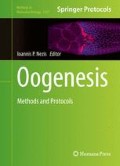Abstract
Real-time (quantitative) PCR, or QPCR, has become an indispensible tool for characterizing gene expression. Depending on the experimental design, researchers can use either the relative or absolute (standard curve) method to quantify transcript abundance. Characterizing the expression of genes in mosquito ovaries will require use of the standard curve method of quantification. Here, I describe reagents and equipment necessary to run standard curve QPCR. I also provide details on the construction of the standard linear curve and calculations required to determine transcript abundance.
Access this chapter
Tax calculation will be finalised at checkout
Purchases are for personal use only
References
Telang A, Wells MA (2004) The effect of larval and adult nutrition on successful autogenous egg production by a mosquito. J Insect Physiol 50:677–685
Dana AN, Hong YS, Kern MK et al (2005) Gene expression patterns associated with blood-feeding in the malaria mosquito Anopheles gambiae. BMC Genomics 6. http://www.biomedcentral.com/1471-2164/6/5
Marinotti O, Nguyen QK, Calvo E, James AA, Ribeiro JMC (2005) Microarray analysis of genes showing variable expression following a blood meal in Anopheles gambiae. Insect Mol Biol 14:365–373
Telang A, Rechel JR, Brandt JR, Donnell DM (2013) Analysis of ovary-specific genes in relation to egg maturation and female nutritional condition in the mosquitoes Georgecraigius atropalpus and Aedes aegypti (Diptera: Culicidae). J Insect Physiol 59:283–294
Wang Z, Gerstein M, Snyder M (2009) RNA-Seq: a revolutionary tool for transcriptomics. Nat Rev Genet 10:57–63
Marinotti O, Capurro ML, Nirmala X, Calvo E, James AA (2006) Structure and expression of the lipophorin-encoding gene of the malaria vector, Anopheles gambiae. Comp Biochem Physiol B Biochem Mol Biol 144:101–109
Harizanova N, Georgieva T, Dunkov BC, Yoshiga T, Law JH (2005) Aedes aegypti transferrin. Gene structure, expression pattern, and regulation. Insect Mol Biol 14:79–88
Kaufmann C, Merzendorfer H, Gade G (2009) The adipokinetic hormone system in Culicinae (Diptera: Culicidae): molecular identification and characterization of two adipokinetic hormone (AKH) precursors from Aedes aegypti and Culex pipiens and two putative AKH receptor variants from A. aegypti. Insect Biochem Mol Biol 39:770–781
Telang A, Peterson B, Frame L, Baker E, Brown MR (2010) Analysis of molecular markers for metamorphic competency and their response to starvation or feeding in the mosquito, Aedes aegypti (Diptera: Culicidae). J Insect Physiol 56:1925–1934
Alto BW, Reiskind MH, Lounibos LP (2008) Size alters susceptibility of vectors to dengue virus infection and dissemination. Am J Trop Med Hyg 79:688–695
Sieglaff DH, Duncan KA, Brown MR (2005) Expression of genes encoding proteins involved in ecdysteroidogenesis in the female mosquito, Aedes aegypti. Insect Biochem Mol Biol 35:471–490
Christophers SR (1911) The development of the egg follicle in Anophelines. Paludism 2:73–87
Paton MG, Karunaratne SH, Giakoumaki E, Roberts N, Hemingway J (2000) Quantitative analysis of gene amplification in insecticide-resistant Culex mosquitoes. Biochem J 346(Part 1):17–24
Acknowledgment
This QPCR technique was developed during work funded by NIH/NIAID grant K22AI070644 to A. Telang, and I thank Julie Rechel for technical assistance during this work. The University of South Florida Sarasota-Manatee Arts and Science Dean’s fund to A. Telang also supported this work.
Author information
Authors and Affiliations
Corresponding author
Editor information
Editors and Affiliations
Rights and permissions
Copyright information
© 2016 Springer Science+Business Media New York
About this protocol
Cite this protocol
Telang, A. (2016). Quantitative Real-Time PCR Analysis of Gene Transcripts of Mosquito Follicles. In: Nezis, I. (eds) Oogenesis. Methods in Molecular Biology, vol 1457. Humana Press, New York, NY. https://doi.org/10.1007/978-1-4939-3795-0_9
Download citation
DOI: https://doi.org/10.1007/978-1-4939-3795-0_9
Published:
Publisher Name: Humana Press, New York, NY
Print ISBN: 978-1-4939-3793-6
Online ISBN: 978-1-4939-3795-0
eBook Packages: Springer Protocols

